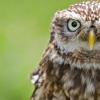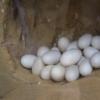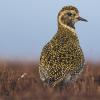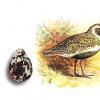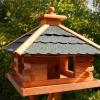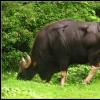Message around the world on the topic: “Natural zones of Russia. Steppe zone. Homework assignments
Plan
1. Location
2. Climate
3. Soil
4 Plant world
5. Animal world
6. Power circuits
7. Environmental issues
8. Reserves
1. Location
The steppe zone on the map is highlighted in yellow

steppe zone located south of the forest zone The steppe zone is much smaller than the forest zone Most of the steppe zone is located on the East European Plain, and it is also found in Western and Eastern Siberia. The surface relief is even. The steppe zone is located in the temperate climate zone.
2. K lim at
To the south of the forest zone, there is even more heat, but less precipitation. Summer is long and dry. In July + 22 - + 25 degrees, the heat can reach up to 40 degrees. The weather is dry and sunny. Often blow dry hot winds - dry winds . Sometimes dry winds turn into dust storms.
Winter is short and warm, but there are colds down to -20 -30 degrees.
In spring, the steppe comes to life, covered with a carpet of tulips and irises. Spring is short with plenty of moisture in the soil. The rains are torrential. A downpour passes quickly, and most of the water, not having time to water the soil, flows down in streams into the lowlands and evaporates.
3. Soil
Soils in the steppe fertile, covered with black soil. Grasses grow in the steppe, each year their dying stems and leaves increase the fertile layer.
4. Plant world
The lack of moisture does not create conditions for the growth of trees.
grow up tulips, irises, feather grass, fescue, steppe timothy, fine-leaved peony .
The shape of the leaves is narrow so that less moisture evaporates; the color is light, because does not allow the sheet to heat up too much. Light colors reflect the sun's rays better.
Root system:
bulb, bunch, rhizome.
Nutrients are stored in the bulb. The fibrous root system better collects and retains moisture from the surface of the earth. In tall plants, the root system goes deep into the soil.
All steppe plants are herbaceous, growing on fertile soil. Plants adapt to life in the steppe in different ways: for example, in tulips, which have beautiful flowers, after flowering, the leaves and stems die off, and the bulb remains in the ground with a supply of nutrients until next spring. Irises and meadowsweet have also adapted. The meadowsweet has tuberous thickenings on the roots, reserve nutrients are deposited there, they can even be eaten. Quite differently adapted feather grass and fescue. They grow in the form of a large dense bush. Below, near the ground, numerous shoots are tightly pressed against each other. The leaves of feather grass and fescue are narrow so that less moisture evaporates, the roots go deep into the ground.
5. Animal world
There are no trees in the steppes, but there is a grassy cover. Therefore, many insects live in the grass: a filly, a grasshopper, a bumblebee, and others. If there are insects, then there are many birds here: the steppe lark, bustard, gray partridge, demoiselle crane. Steppe birds build their nests right on the ground. Steppe animals are not large, their life is connected with the ground in which they make holes. Ground squirrels, hamsters, field mice live in the steppe. And, of course, there are predators in the steppe: steppe eagle, steppe polecat, steppe viper. The color of steppe animals often matches the color of vegetation.
 steppe eagle
- predatory bird. Nests on the ground. The fingers are weak, the claws are short, it feeds on small animals (rodents, birds). Wingspan up to two meters.
steppe eagle
- predatory bird. Nests on the ground. The fingers are weak, the claws are short, it feeds on small animals (rodents, birds). Wingspan up to two meters.
Kestrel - bird of prey.
steppe lark We have been hearing his song since early spring. Only the male sings. They feed on insects, carrion.
Bustard - the largest bird, weight from 16 to 21 kg. Runs well and flies well. It rises into the air heavily from a run. It flies against the wind, low, gradually gaining height. There are no sweat glands, it is difficult to have in the heat, there is no grease.
gray partridge - looks like a small chicken, also cackles and rakes the ground with its paws. Destroys a set of insects, harmful to agricultural. The meat is very tender and tasty.
Gophers - do not go far from the holes. Having risen on their hind legs, they look around all the time, and noticing a person or animal, they hide in a hole with a squeak. In dry years, with the onset of starvation, they hibernate. They can sleep up to 9 months.
steppe vipers - in weeds and ditches. They feed on rodents and insects.
6. Power circuits
Plants—> Filly—> Partridge—> Steppe Eagles
—> Foxes
—> Wolves
Plants—> Jerboa—> Steppe Eagle
7. Environmental issues
Many plants and animals of the steppe zone are threatened with extinction. The main reason is plowing steppe lands . People have turned the steppes into fields. Another reason: cattle graze on unplowed areas of the steppes, and excessive grazing leads to soil destruction. The following animals are included in the Red Book: steppe eagle, crane, bustard, grasshopper, steppe dyke. Plants: thin-leaved peony.
There is another problem - this poaching . In order to preserve the nature of the steppes, it is necessary to limit its plowing, limit livestock grazing, fight against poaching, and create nature reserves.
How to solve environmental problems?
- Limit the plowing of the steppes:
- Limit livestock grazing;
- Combat poaching;
- Create reserves;
Before plowing the fields, collect bustard eggs and grow them in special incubators. And then put on the field.
8. Reserves

Central Chernozem Reserve named after V. V. Alekhin - in the strip of the northern steppe of the Kursk and Belgorod regions. Founded in 1935 and named after a famous geobotanist, professor at Moscow University. The area is over 4 thousand hectares. The areas of the Streletskaya, Cossack and Yamskaya steppes are of the greatest interest. 31 species of mammals have been recorded in the reserve, but if we exclude some entering animals (elk, roe deer, wolf, etc.) and acclimatized ones (raccoon dog), then about 25 native species remain. The marmot, a typical inhabitant of the virgin steppe, was exterminated in the last century. Traces of his stay are still preserved in the steppes in the form of small mounds (surochin), overgrown with steppe vegetation. In addition, spotted ground squirrel, mole rat and a number of other species of fauna come across here.
Views: 73 629
You may be interested

The steppe zone is located south of the forest zone. These are endless flat spaces covered with a grassy carpet. Only occasionally in the steppe can one find single trees or small groups of trees that grow near water bodies. This natural area is found on all continents.
Climate features
The forest zone gradually, through the forest-steppe, passes into a treeless natural zone - the steppe. It looks like a huge field on which fragrant herbs grow.
The steppe zone is located in the temperate climate zone. This means that sunny, dry weather reigns here. Dry winds are typical for this area - hot dry winds that can turn into strong dust storms.
Summer in the steppe is long, dry, with little rainfall. The average temperature is 20-22 degrees Celsius, but sometimes it can rise to 40 degrees. Winter is short and relatively warm. Only occasionally the air temperature drops to -40 degrees.
In spring, the steppe seems to wake up: life-giving showers moisten the soil, and it is covered with a carpet of bright steppe flowers. However, due to sunny weather, rainwater does not have time to penetrate deep into the ground. It flows into the lowlands and quickly evaporates.
TOP 4 articleswho read along with this

Rice. 1. Steppe in spring.
The main wealth of the steppe zone is fertile lands, which are called chernozem. Dying, herbs form the upper nutrient layer - humus, which has unique nutritional properties.
Vegetable world
Due to the low amount of moisture, very few trees grow in the steppes. The main vegetation in this natural area is all kinds of herbs and cereals.

Rice. 2. Steppe plants.
Steppe plants are characterized by the following features:
- narrow leaves - to evaporate a small amount of moisture;
- light color of foliage - better reflects the sun's rays;
- numerous small roots - better absorb and retain valuable moisture.
Peonies, irises, tulips, feather grass, fescue and many medicinal plants grow in the steppe.
Animal world
Prevailing vegetation cover created ideal conditions for the life of insects, of which an incredible number lives here. Grasshoppers, grasshoppers, bumblebees, bees and many others live in the steppes.
Since there are many insects in the steppe, it means that many birds live here: partridges, steppe larks, bustards. They equip their nests right on the ground.
Steppe animals are maximally adapted to life in the field: they are all small in size, with a light color that blends with the vegetation. The steppes are inhabited by many rodents and reptiles.
Gophers are typical inhabitants of the steppes. They spend a lot of time standing on their hind legs and looking around. At the slightest danger, they hide in their burrows with an alarming squeak. In unfavorable years, with severe drought and lack of food, they hibernate, which can last 9 months.

Rice. 3. Gophers.
Ecological problems of the steppes
The main problem of the steppe zone is its plowing for agricultural needs. Fertile soils and the absence of trees were a good reason why people began to plow up the steppe lands and grow cultivated plants on them.
In addition, cattle are grazed in the unplowed steppe areas, and this inevitably leads to the destruction of the unique soil.
As a result of human activity, many steppe animals and plants are under the threat of extinction.
What have we learned?
When studying the report on the program of the 4th grade of the world around us, we learned what the steppe zone is like. We found out what kind of climate is typical for this natural zone, what plants and animals live in the vast expanses of the steppe, and also what is the main environmental problem of the steppes all over the world.
Topic quiz
Report Evaluation
average rating: 4.8. Total ratings received: 411.
The steppe is a flat landscape zone located in the temperate and subtropical zones of the Northern and Southern Hemispheres. Steppes are distributed on all continents, with the exception of Antarctica.
Unfortunately, this kind of natural landscape is gradually disappearing from the face of the earth. There are many reasons: plowing the land, poaching, intensive grazing, fires.
General characteristics of the steppe
The steppes are characterized by the almost complete absence of trees. Exceptions are artificial plantations along paved roads and forest belts near water bodies. But in the steppe grows a large number herbaceous plants and shrubs.
However, it is worth remembering that the flat treeless space with a humid climate is no longer a steppe. This is a zone of swampy meadows, and in the north, under such conditions, tundra is formed.
Natural zones of the steppes

The steppe natural zone is located between the forest-steppe and the semi-desert. The steppe is a treeless expanse, completely covered with grasses. Grasses form an almost closed carpet.
Steppe plants are distinguished by their ability to endure drought and heat. As a rule, the leaves of steppe plants are small, grayish or bluish-green. Many plants have the ability to fold their leaves during times of drought to prevent evaporation.
Since the steppes occupy vast areas, plant species are very diverse. Of great importance for humans are, first of all, fodder plants: clover, alfalfa, corn, sunflower, Jerusalem artichoke. Beets, potatoes, as well as cereals: oats, barley, millet.
Medicinal herbs and honey plants are also distinguished among steppe plants.

Steppe animals are not much different from the fauna of deserts and semi-deserts. They also have to adapt to hot summers and freezing winters. Of the ungulates, antelopes and saigas are most common, of predators - foxes, wolves and manuls. There are many rodents (ground squirrels, jerboas, marmots), reptiles and insects. Steppe eagles, bustards, larks, and harriers are commonly found among steppe birds. Most representatives of birds fly away to warmer climes in winter.
Many steppe animals and birds are on the verge of extinction and are listed in the Red Book.
Steppe types
Types of steppes are distinguished depending on the ratio of cereal and herbaceous plants.

. Mountain- characterized by lush forbs. An example is the mountain steppes of the Caucasus and Crimea.

. Meadow, or mixed herbs - the largest number of species of steppe plants grows here. Meadow steppes are in contact with forests, and their soils are rich in chernozem. This species includes most of the steppes of the European part of Russia and Western Siberia.

. xerophilic- with an abundance of turf grasses, mainly feather grass. This type of steppe is often called feather grass. For example, the southern steppes in the Orenburg region.

. Desert, or deserted. There are most of all wormwood, tumbleweed, prutnyak and ephemera. Such were the once rich, herbal steppes of Kalmykia, which, as a result of human activity, are gradually turning into deserts.
Steppe climate

The main feature of all steppes is aridity. The type of climate is from temperate continental to sharply continental. The average annual rainfall rarely exceeds 400 mm. Windy weather prevails in the steppes, and summer is characterized by a large number of sunny days. Winters are not snowy, but snowstorms and blizzards are frequent.
Another feature of the steppes is a sharp drop in day and night temperatures, since at night the temperature can drop by 15-20ºC. These conditions make steppes related to deserts.
Dust storms often occur in the steppes, which affect soil erosion and lead to the formation of gullies and ravines.
The soils of the steppes located in the temperate climate zone are very fertile and are actively used in agriculture. Chernozem is the basis, chestnut soils are found only closer to the southern latitudes.

AT different countries the steppes have their own name. In Australia and Africa it is the savanna, in South America it is the llanos and the pampas, or pampas, in North America it is the prairie, and in New Zealand it is the Tussoki.
In Europe, the steppes have been preserved mainly in protected areas. But in Siberia there are still virgin steppes - Kurai, Chui.
For 1 sq. km of steppe space inhabited by more insects than people in the whole world.
The largest birds live in the steppes. In Russia - bustards, and in Africa - ostriches.
Lesson Objectives:
To form an idea of the natural zone of the steppes, to acquaint with the geographical position of the zone, climatic conditions, flora and fauna.
Lesson objectives:
- To form an idea of the natural zone of the steppes, to introduce geographic location zones, climatic conditions, flora and fauna.
- Develop the ability to work with a map, teach children to observe, reason, draw conclusions, evaluate their activities in the lesson and the activities of classmates.
- Instill respect for nature.
Equipment: PC, MIMIO, projector, map of natural areas.
For students: a sheet for recording knowledge in the lesson, a map of the lesson, the “Forest Zone” test, cards for self-assessment: yellow tulip - 3, iris - 4, red tulip - 5 ( Appendix 1)
During the classes
I. Organizational moment. Student motivation.
– Today we will continue our journey through natural areas, where you will meet with amazing flora and fauna, learn about climate features and occupations of the population, about nature protection,
But first, let's review what we've learned so far.
II. Checking homework. Knowledge update.
1) Students complete the test “Forest Zone”
Examination. One student names his answer options, opening the MIMIO “blinds” on the board for the intended answer, students see the correct answer. The rest of the students self-check their work, marking the errors in a different color.
After checking, a slide appears on the board with the criteria for evaluating the work. Pupils paste a picture on the self-assessment sheet corresponding to their assessment in the “test” column (yellow tulip - 3, iris - 4, red tulip - 5)
(Self-assessment: 5-7 correct answers - "3", 8-9 right answers - "4", 10 right answers - "5".)
III. The topic of the lesson. Goal setting.
Students solve a crossword puzzle on the topic “Forest Zone” (Front work)
Having solved the crossword puzzle, the children will learn the topic of the lesson.
- The topic of our lesson is “Steppe zone”.
We have already met with several natural areas. (Students name the studied natural areas, show on the map).
- We studied all natural areas according to a certain plan. We remind each other the plan for studying the natural zone.
Students recall the plan for studying the natural area, compare with the standard:
- Geographic location of the zone
- Climatic conditions (combination of heat and moisture)
- Vegetable world
- Animal world
- The impact of human activities on natural areas
Thus, we can formulate the purpose of the lesson. (Children formulate a goal).
- In the steppe zone you will meet with amazing flora and fauna, learn about the climate, about nature protection,
Since we are going on a trip, we need to map out a route. (Drafting a route sheet) ( Annex 2)
Fizminutka
IV. Working on a new theme.
Viewing the presentation “Steppe in different time of the year"| Climatic conditions | |
| Average temperature in summer | +22-24, July to +40 |
| Average temperature in winter | -20-30 |
| Precipitation in summer | small, The torrential nature of the rains |
| Precipitation in winter | Snow cover low |
| Vegetable world | |
| Trees | No, not enough moisture |
| shrubs | No, not enough moisture |
| herbaceous plants | Yes |
| How plants adapted to conditions in the steppe | 1) bulbs, tubers 2) Narrow leaves 3) Long roots 4) fleshy juicy stems and leaves |
| Why are steppe soils very fertile? | |
| plant name | Basic information |
| Animal world | |
| Animal name | Basic information |
| Steppe and man | |
4. Teacher's story
Steppes are large treeless spaces, grassy plains. Summer in the steppes is longer than in the forest zone. The average temperature in summer is 22-24 degrees, in July it can rise up to 40 degrees above zero. Summer is dry and sunny, rains are rare, they have a shower character. Water flows into the lowlands, not having time to soak into the soil and quickly evaporates. There is not enough moisture in the soil, so trees do not grow in the steppes. Dry winds often blow in summer. Dry wind - dry, hot wind coming from the desert. This wind brings a lot of trouble.
Winter in the steppe is shorter and warmer than in the forest zone. But quite cold, with frosts up to 20-30 degrees. Snow cover is small.
As already mentioned, due to lack of moisture, trees do not grow in the steppes, but there are many herbs. The grasses have adapted well to drought. Some plants have leaves with a wax coating, others have narrow leaves that evaporate little moisture, and others have fleshy and juicy stems and leaves with a supply of moisture.
Some plants have roots that go deep into the ground to reach water, while others form tubers and bulbs.
Spring in the steppe begins early, in February-March the snow already melts and moisture accumulates in the soil.
At this time, bulbous plants grow. In a month, these flowers have time to develop, bloom, bloom, give seeds and wither. They have enough during this month, a supply of nutrients and moisture accumulates in the bulbs. It gets hotter and you will no longer see the tulips and irises of the steppe. They are replaced by cereal plants.
These plants have narrow leaves that evaporate moisture sparingly. Roots help the plant resist when dry winds blow.
By the end of summer - the beginning of autumn, the steppe almost completely burns out.
The steppes have fertile soils, so they are plowed up for crops.
- Grasshopper
- filly
- crickets
- butterflies
- bees, bumblebees
- steppe wolf
- saiga
- Gopher
- hare
- Bustard
- steppe eagle
- steppe lark
- gray partridge
6. Steppe and man. Work with the textbook. S. 120.
Reading conversation. Filling in the table.
V. Application of knowledge.
Mutual verification. Evaluation.
Reflection.
What tasks did you particularly enjoy?
- What interesting things did you learn at the lesson?
Summing up the self-assessment sheet.



